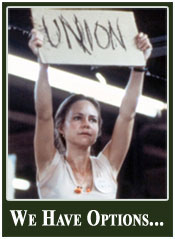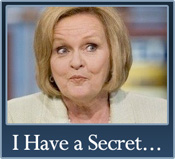Letter to American VP Denise Lynn
Any failure to meet corporate expectations is an executive failure, not an employee failure
Written to Denise Lynn after she told flight attendants that they didn't meet the corporate expectations for their AIP payment but somehow the executives that ran our airline into the ground did.
From: Rock Salomon <rocksalomon@hotmail.com>
Date: Mon, 16 May 2011 14:26:44 -0400
To: "AA.Flight.Service@aa.com" <AA.Flight.Service@aa.com>
Cc: "APFA Membership" <newapfa@yahoogroups.com>, APFA <communications@apfa.org>, "Ahles, Andrea" <aahles@star-telegram.com>, "Maxon, Terry" <tmaxon@dallasnews.com>
Subject: Re: Flight Service Update for 5/11/2011
As an employee, Ms. Lynn, I feel the need to comment on your latest Flight Service Update: "How Do You Impact the Experience." The idea that employees somehow failed to meet the Customer Satisfaction standards set forth by AMR's executives while the executives themselves were worthy of a thirty-five million dollar performance based payout is absurd. This airline is run by executives, not employees. Any failure to meet corporate expectations is an executive failure, not an employee failure. Labor and management are not a teAAm as management would have us believe; when employees "pull together," executives "win together."
When we consider that American Airlines came in LAST (11th) among its peers in the 2011 Airline Quality Ratings (AQR) and that American Eagle came in at #16 — ABSOLUTE LAST — that alone is a testament to AMR's corporate failure. Somehow, though, AMR's chairman, Gerard Arpey, and president, Tom Horton, were graciously rewarded. Mr. Arpey received an 11% pay increase last year and Mr. Horton received a 45% pay increase. Flight attendants who work for wages negotiated in 1995 received nothing. For you to suggest that flight attendants aren't worthy of their $50 pittance because of corporate shortcomings is a tell-tale sign as to why the two airlines did so poorly in the ratings. Our executives are completely out of touch.
I get the impression from your Update that many in AMR's executive echelon have forgotten what employees have done for this airline. Since 2003, American's employees have contributed approximately $14.4 billion in an effort to subsidize poor corporate governance. Flight attendants alone have contributed $2.7 billion in corporate welfare so as to shore up American's bottom line. When I consider executive contributions to the cause, I simply can't think of any.
Just so that we're all on the same page, I'd like to remind our executives of just how much my union, APFA, has given American over the last eight years. APFA has given and given and given some more, all without asking for anything in return. What have the AMR executives given??? Exactly my point.
Please feel free to share my thoughts in your next Flight Service Update; and if you could, please let AMR spokesperson Missy Latham Cousino know that this isn't "union rhetoric."
Respectfully,
Rock Salomon
Flight Attendant BOS
In 2011, Laura Glading forfeited Seniority in an effort to allow American to hire and employ first-year new-hire speakers before recalling those who have been on furlough for eight years.
In 2010, Ms. Glading offered up the union's Antitrust Immunity Endorsement for free so that American could generate $500M in additional annual revenue with its Joint Business partners.
In 2005, Tommie Hutto-Blake forfeited Manning Positions on the MD-80, 737, 757 and 767-300 so the the company could staff less and recall fewer.
Ms. Hutto-Blake also promoted AMR's quest for Pension Reform to Congress so that AMR could underfund the flight attendants' defined benefit plan.
In 2003, John Ward and negotiator, Laura Glading, reduced, eliminated, or raised the cost of the following without demanding anything in return — not even proof of necessity.
— Reduced Pay Rates by 15.6%
— Reduced Vacation by 33%
— Eliminated the Pre-Vacation 48 (2 days added to our vacations)
— Reduced Per-Diem to $1.50 Dom./$1.75 Int'l.
— Reduced Premium Rates 50% (Purser, Language, Galley)
— Eliminated Reserve Override
— Eliminated Longevity Bonus
— Eliminated Narrow Body Lead Pay
— Eliminated Night Pay
— Reduced Layover Rest to FAA Minimums
— Eliminated Benefits for Overage Leaves (except retain bidding seniority and passes)
— Raised the Rolling Annual Hourly Threshold to Accrue and Receive Benefits (420 Hours per Year)
— Eliminated Article 6e Vacation Benefits
— Eliminated Crew Meals for Domestic and Int'l
— Reduced Sick Accrual to 3 hours per Month/Eliminate Rapid Re-accrual
— Increased Trip Selections to 77 Hours Domestic and 82 Int'l
— Raised the Threshold for Incentive Pay to 70 hours from 67
— Eliminated All Paid Holidays
— Eliminated EPT Training Pay up to 12 Hours
— Reduced Uniform Point System from 18 Points to 12 with ZERO Carry Over
— Reduced Deadhead Credit from 100% to 50%
— Eliminated IOD Salary Continuance
— Reduced Language Pay to Only the Market Flown
— Reduced Last Trip of the Month Pay Protection from Last 7 days to Last 5 Days
— Eliminated Furlough Pay
— Eliminated Part-Time
— Reduced Line Holder Guarantee to 70 Hours
— Raised Monthly Maximum to 80 Domestic and 85 Int'l
— Raised Medical Benefit Contributions to Double the Current Rate
2011 Airline Quality Ratings:
1. AirTran 1.63
2. Hawaiian 2.23
3. JetBlue 2.48
4. US Airways 2.56
5. Frontier 2.58
6. Continental 2.65
7. Alaska 3.13
8. United 3.40
9. Southwest 3.43
10. Delta 3.49
11. American 3.82
12. Mesa 3.97
13. SkyWest 4.72
14. Comair 5.28
15. Atlantic Southeast 6.71
16. American Eagle 7.15
On 5/11/11 8:34 PM, "AA.Flight.Service@aa.com" <AA.Flight.Service@aa.com> wrote:
Posted: 5/11/2011 3:32:17 PM
Title: How Do You Impact the Experience?
May 11, 2011
May 13 is Customer Experience (CE) Rewards Day, and as you know, our quarterly CE Rewards checks are tied to how well we do on our customers' rating of their Overall Onboard Experience in addition to Direct D-0 dependability. Unfortunately, we did not achieve our Customer Satisfaction Survey (CSS) or dependability goals for January, February or March, so we will not have a CE Rewards payout this week.
There's no question that providing an exceptional onboard experience to our customers is key to our success. Each year, we have an opportunity to earn up to $1,200 in CE Rewards for meeting our onboard service goals. That's $600 ($50 per month) for our Direct D-0 dependability targets, and $600 ($50 per month) for our Overall Onboard Experience CSS rating. I know we all want to be successful in meeting these goals, so I think it may be helpful to break this down a bit to see what happened in the first quarter. Let's start with Direct D-0 dependability, because there may be some misconception about what we are measured on in this category. A flight attendant recently sent a great question to JetNews Q&A. He asked:
Do our CE Rewards related to the D-0 stats include OR exclude flights that are delayed due to weather, ATC, mechanical, security breach, catering delays, ramp delays, Passenger Service delays, delayed baggage, anything that is beyond our control?
The answer to that question is
Direct D-0 measures the percentage of scheduled revenue operations for a given month departing at or before scheduled departure time. It measures delays that occur due to factors within the control of Maintenance, Customer Service, Flight and Flight Service. It does not measure delays that occur due to factors generally outside our control such as those caused by weather, Air Traffic Control, System Operations Control, and Late Through flights.
All AA employees share the same Direct D-0 goal under the CE Rewards program, so we all need to work together to be successful. For our part, this means being at the gate on time, and partnering with the agents to ensure an early or on-time departure. We missed our Direct D-0 goals for the first three months by only a small margin, so with everyone focused on Streamlined Boarding and improved dependability we should be able to get this on track as we move forward.
The other component of our CE Rewards formula is our Overall Onboard Experience CSS ratings. This measure applies only to Flight and Flight Service; other departments have CSS goals tied more closely to the service they provide - for example, CE Rewards for agents and fleet service clerks are based on the Overall Airport Experience.
Looking back at our CSS ratings, we showed continuous improvement in the eyes of our customers in regard to our personal interactions from the second half of 2008 through early 2010. In the second half of 2010, the scores across all workgroups began to decline. While we are still delivering good customer service, our customers' expectations are higher and our competition is raising the bar, and this means we need to do even better in order to distinguish ourselves. Consistently delivering the welcoming, helpful, personal service our customers tell us that they value is the key. Being courteous, available and attentive in the cabin, thanking our customers for their business, and addressing our premium customers by name every time, on every flight we work. That's what will make the difference going forward.
I frequently share compliment letters here in my Update because I think it's important that we understand what specific actions onboard our flights have created positive and memorable experiences for our customers. These experiences form lasting impressions that endear us to our customers and earn their loyalty, and we all need to be able to identify what we can personally do to make that kind of difference. There's no question that you have more personal contact with our customers than anyone else in our airline, so you also have the greatest potential to influence their experience, and that's what comes through loud and clear in every compliment letter I read. The main theme in these positive stories is this:
:
During a personal interaction with a customer, a flight attendant has positively affected a customer's experience by doing or saying something that impacted the way the customer felt about their flight and about American Airlines - enough to take the time to write and tell us about it.
Case in point, the experience described in this customer letter that Miami-based Flight Attendant Bill Price created for an entire cabin of customers.
Rarely am I impressed to the point of being compelled to write or comment in this fashion. I am just not easily impressed, but I truly appreciate and admire people who are the very best at whatever they do. So after all these years, and after one flight, I admire Bill Price. He is the Michael Jordan of the skies.
So out of all of my flights, miles and travels, what one thing did Bill price do that was, in and of itself, so extraordinary? Nothing.
What he did do was EVERYTHING - EXTRAORDINARILY WELL - FOR EVERYBODY.
Professional; personal; attentive; friendly; incredible attention to details; helpful, etc., etc., etc. It was as if he had just launched his own airline with his personal reputation at stake, and was on board to personally make sure it all went well.
And now, as I think about it, he did do one thing that was truly simple, but extraordinary:
Toward the end of the flight, he literally walked through the first class cabin, stuck out his hand to every passenger, and personally and genuinely thanked every one of us, by name, for choosing American. I have never seen anything like it in my entire flying life. If he is an actor, he should go to Hollywood. If he is a politician, where do I vote for Bill Price?
Please confirm that you have received this note. I would also ask that you confirm my note has been forwarded on directly to your CEO - Mr. Gerard Arpey. If they can figure out a way to bottle or clone Bill Price, you would stand a good chance of putting the other airlines out of business.
Firsthand accounts like this of positive experiences with a company are perhaps the best form of word-of-mouth advertising that anyone in the service industry could hope for. You inspire these positive stories every time you have a personal interaction with one of your customers, even if they don't write to tell us about it. The fact is we live in a world of instantaneous and viral communications and many people tweet and post to airline and business blogs. Those messages can be received by millions of other users around the world very quickly. Word of mouth accounts of in-flight experiences abound, as people talk to their colleagues, friends and family about their recent flight on AA. How many times have you been in a social setting and, when asked "what do you do?" have you been presented with a story about an experience someone had when flying on AA? Whether it's good or bad, people love to share their airline stories!
Bill knocked it out of the park with the incredibly powerful yet simple act of personally thanking customers for their business. That's one of our core service practices, and this letter illustrates why we've been stressing the importance of focusing on our onboard service standards each and every day. We want to be the airline whose flight attendants are widely known to be available and attentive, who always address their premium customers by name, and who thank their customers for their business and their loyalty. These are the opportunities to create a personal connection with the customer and leave a lasting impression.
We absolutely need to set AA apart from the competition in the minds of our customers. This is critical not just to this month's or next month's CE Rewards, but to secure our long-term future. So in closing, I respectfully ask you to think about my opening question, the title of this week's Update, "How are you impacting the experience?" It's going to take everyone doing their part to consistently provide our customers with the experience that will earn their loyalty to AA. I know with a continued focus on our service standards and our CE goals we'll get our CE Rewards back on track.
Thank you for taking the time to read this Update and for all that you do to create a first-rate inflight experience for our customers.
Yours,
Denise Lynn
------ End of Forwarded Message











